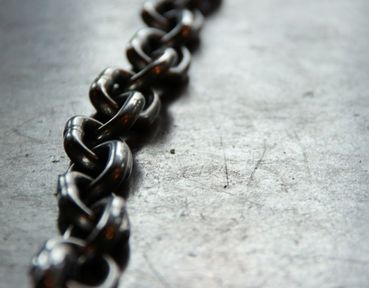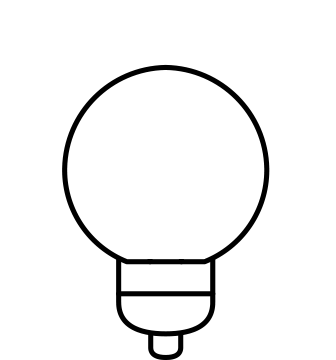Choose the right luminaire material
When installing garden lighting, it is not only important to choose visually appealing materials. They should also be able to withstand the harsh outdoor conditions. It is therefore essential to opt for high-quality, robust materials such as stainless steel, coated aluminium or even hard-wearing stone. These materials offer the necessary durability and weather resistance to ensure that your lighting solutions will last.
Near the coast, it is important to choose lighting components that are resistant to salt air and sand corrosion. Choosing products that are specifically designed to resist corrosion can significantly extend the life of your installations. At the same time, they ensure the safety and reliability of the lighting system.
Make sure that seals made of rubber or other materials are firmly seated. This will prevent the ingress of moisture. Covers made of glass or high-quality plastic must not be cracked or broken.
In addition to choosing the right materials, regular maintenance and care of garden lights is essential. Routine inspection and cleaning can help to preserve the attractive appearance of outdoor lighting. At the same time, you ensure that each light fulfils its function optimally. This includes checking all connections, tightening loose parts and replacing worn components. In this way, you maximise the longevity and effectiveness of your lighting solutions.
/f/113144/315x276/175f1a2db2/slv_web_image-text-teaser_25-75_315x276px_dos-and-donts-photoni.jpg)
Choose the right IP protection class
The IP protection class indicates the extent to which electrical devices are protected against the ingress of foreign bodies (including dust) and water. The labelling consists of the prefix "IP" followed by two digits: The first digit rates the degree of protection against the ingress of solid foreign bodies, while the second digit describes the degree of protection against water.
A minimum protection class of IP44 is essential for luminaires that are used outdoors. This classification ensures that the luminaires are effectively protected against splash water. However, it is important to note that in certain cases a higher protection class such as IP65 or IP67 may be required. This may be the case with direct exposure to heavy rain or close to the ground where water splashes can be more intense.
You should also consider whether additional protection against dust and fine particles (indicated by a higher first digit, e.g. IP5X or IP6X) is necessary, especially in dusty or sandy environments. A higher degree of protection can improve the longevity of the lighting units and reduce maintenance requirements and the risk of failure.
Recessed floor luminaires that are directly exposed to the weather and possibly to stress from being walked or driven on require an even higher level of protection. A protection class of at least IP65 is recommended here to ensure complete protection against dust as well as protection against water jets from any angle. This degree of protection is essential to ensure the functionality and safety of the luminaires under the demanding conditions of direct ground contact.
For installations where the luminaires could be completely submerged in water for a period of time, protection class IP67 or higher is recommended. This ensures that the luminaires function reliably under extreme conditions.
Choosing the right IP protection class is not just a question of technical requirements. It is also a guarantee for the safety and satisfaction of the end user. You should always carry out a comprehensive assessment of the environmental conditions and select the appropriate protection classes.
The outdoor lights from SLV undergo a series of tests to ensure the specified IP protection.
The IK class (link to article IK classes) quantifies the resistance of outdoor luminaires to mechanical impacts, among other things. IK classes therefore provide a clear guideline for the selection of suitable luminaires depending on the requirements of the installation site.
Luminaires used outdoors are not only exposed to the elements, but also to everyday physical stresses. Whether it's an accidental bump with a rake while gardening or the energetic handling of balls by children playing in the garden, all these scenarios test the resilience of your installed lighting. Choosing luminaires with an appropriate IK class is essential to ensure that everyday challenges can be overcome without damage or loss of function.
The IK class ranges from IK00 (no protection) to IK10, the highest level, which offers protection against strong knocks and impacts. For outdoor areas where there is a moderate to high probability of mechanical impact, the luminaires selected should have an IK class of at least IK07. These are designed to withstand impacts of up to 2 joules. This is equivalent to being hit with a rake or a football.
/f/113144/315x276/18e0b63884/slv_web_image-text-teaser_25-75_315x276px_dos-and-donts-m-pol.jpg)
Choose flexibility
Ground spike lights are an exceptionally flexible solution for emphasising the diversity of a garden or for highlighting specific elements. Whether you want to emphasise the natural charm of plant arrangements or enhance the safety and atmosphere of paths and patio areas, ground spike lights offer an ideal combination of flexibility and functionality.
Thanks to their compact design and the ability to swivel and rotate, these lights allow the light to be directed precisely. This allows you to emphasise specific garden features or make dangerous tripping hazards on the path clearly visible. The installation of these versatile light sources is designed to be user-friendly. Many models are supplied with a robust base plate or a sturdy bracket that can be permanently fixed to the ground using screws. Alternatively, the ground spikes supplied offer a quick and uncomplicated way of anchoring the lights directly in the ground or lawn. This allows flexible positioning and easy relocation if required.
The versatility of ground spike lights makes them an indispensable tool for any electrician carrying out outdoor lighting projects.
Choose sustainable light sources
It may seem obvious, but choosing LED technology for your garden lighting offers significant advantages. LED light sources are characterised by their exceptionally long service life and low energy consumption. This makes them a sustainable and cost-effective solution for any outdoor lighting task. These attributes not only help to protect the environment, but also enable property owners to significantly reduce their operating costs.
It is important to dispel a widespread myth: the assumption that LED light sources do not generate heat. In fact, LEDs do generate heat, albeit to a lesser extent than conventional light bulbs. This heat generation can become a critical factor in outdoor luminaires if the design of the luminaire allows insufficient heat dissipation. Poor heat management can have a negative impact on the efficiency and service life of LED light sources, especially when it comes to retrofitted, replaceable LEDs.
Before selecting LED light sources for existing outdoor luminaires, it is crucial to carefully check the compatibility between the light source and the luminaire. Make sure that the outdoor luminaire is specially designed for use with LED light sources. It should have an adequate heat management system that enables efficient heat dissipation.
With outdoor luminaires that are equipped with integrated (permanently installed) LED light sources, you can generally assume that the heat management is optimised. This harmonised coordination not only guarantees maximum efficiency and service life of the lighting. It also ensures the best possible light quality and performance for outdoor areas.
/f/113144/315x276/bd100bdda6/slv_web_image-text-teaser_25-75_315x276px_dos-and-donts_cable.jpg)
In addition, it is advisable to treat electrical connections in outdoor areas with particular care. The use of watertight casting sleeves filled with casting resin is a reliable method of securing connections against the ingress of water. This practice thus contributes to the prevention of electrical failures and the safety of the entire lighting system. It is important to consider the specific challenges of the outdoor environment and implement the best possible solutions for safe and effective lighting.
Ensure water drainage with floor spots
With floor spotlights in particular, you should make sure that you install them correctly. A critical aspect is to ensure adequate water drainage to prevent the accumulation of moisture that could damage the luminaires.
An effective way to address this aspect is to create a gravel bed under each floor light. This acts as a drainage layer that efficiently channels water away from the luminaire, preventing the accumulation of moisture. Such a gravel bed not only acts as a physical barrier against water. It promotes the evaporation of moisture, which protects the floor light from potential water damage.
In addition to creating a gravel bed, it is essential that the ground lights are installed on a level or slightly raised surface. Placement on a raised surface facilitates natural water drainage and prevents water from collecting on the luminaire. This is important to avoid the accumulation of water in depressions or pits. By carefully selecting the installation location and paying attention to the topography, electricians can ensure that ground lights are effectively protected from standing water.
The combination of a well-designed drainage system and the strategic positioning of the luminaires contributes significantly to maintaining the function and aesthetics of the floor spots.
/f/113144/315x276/79b745c5be/slv_web_image-text-teaser_25-75_315x276px_dos-and-donts-dasar.jpg)
Do not stare blindly
Finally, a practical tip that applies to all types of lighting, both indoors and outdoors: make sure that your customers are not looking directly into the beam of light when they are looking at a luminaire.
If you want to install recessed floor lights on the patio, install them at a sufficient distance from the table and chairs. If you are pointing a spotlight at a tree, make sure that you position the light in front of the tree. This way, the light is not directly in view. Position path lights low so that they illuminate the ground and do not dazzle. Make sure that your façade lighting shines upwards and downwards (up/down luminaire) and not forwards. Or choose a luminaire with a glare-free cover.
Last but not least: read the operating instructions. It may sound obvious, but it is advisable to read the instructions for use before installing and using lighting products. Each luminaire may contain specific instructions for installation and maintenance. A glance at the instructions for use can protect you from surprises.
 SLV SUBSIDIARIES
SLV SUBSIDIARIES

















 SLV INTERNATIONAL
SLV INTERNATIONAL
/f/113144/1900x466/e1e40c9e49/slv_web_image-teaser-full-size_1900x466px_dos-and-donts.jpg)
/f/113144/274x296/cd9c36670a/slv_web_image-text-teaser_grid-4_274x297px_dos-and-donts_nautilus.jpg)
/f/113144/274x296/a167e053da/slv_web_image-text-teaser_grid-4_274x297px_dos-and-donts_samrina.jpg)
/f/113144/274x296/d8de45643a/slv_web_image-text-teaser_grid-4_274x297px_dos-and-donts_syna.jpg)
/f/113144/373x296/85d019e9b0/slv_web_image-text-teaser_grid-3_373x296px_recessed-spotlight-sinks.jpg)
/f/113144/373x296/24b6e9660e/slv_web_image-text-teaser_grid-3_373x296px_recessed-spotlight-levels.jpg)
/f/113144/373x296/3eeb2718be/slv_web_image-text-teaser_grid-3_373x296px_recessed-spotlights-raise.jpg)
/f/113144/827x668/5180090e9e/all_slv_good-light-solutions_overview-teaser-rusty_827x668px.jpg)

/f/113144/827x668/178b93f2da/slv_de-de_slv_good-light_slider_827x668px_back-to-nature.jpg)
